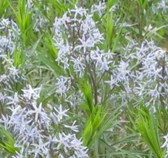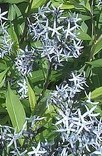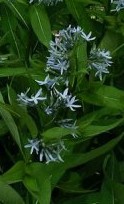 Amsonias, also known as bluestars and dogbane, are subshrubs or perennials belonging to the dogbane family, Apocynaceae, that also includes oleander, periwinkle, and mandevilla. Bluestars are native to North America and represented by about twenty species. Of these, three are good garden plants grown for both their attractive flowers and foliage. All have light blue star-shaped flowers borne in terminal panicles in spring and narrow to ovate leaves that turn yellow in the fall. Stems contain a milky sap. Amsonias like full sun or partial shade and average, moist, well-drained soil. Plants can be propagated by seed, division in spring or fall, and terminal cuttings in spring to early summer.
Amsonias, also known as bluestars and dogbane, are subshrubs or perennials belonging to the dogbane family, Apocynaceae, that also includes oleander, periwinkle, and mandevilla. Bluestars are native to North America and represented by about twenty species. Of these, three are good garden plants grown for both their attractive flowers and foliage. All have light blue star-shaped flowers borne in terminal panicles in spring and narrow to ovate leaves that turn yellow in the fall. Stems contain a milky sap. Amsonias like full sun or partial shade and average, moist, well-drained soil. Plants can be propagated by seed, division in spring or fall, and terminal cuttings in spring to early summer.
The three garden amsonias are herbaceous perennials and similar. They differ in regard to size, leaf characteristics, and hardiness.
 Downy Amsonia (A. ciliata aka A. angustifolia)
Downy Amsonia (A. ciliata aka A. angustifolia) A native of southeastern United States, downey amsonia has pale blue flowers that persist for three to four weeks. The foliage is hairy and dark green when young turning golden yellow in the fall. The linear leaves are crowded on the stem and have margins that curl back. If the foliage is cut back after flowering feathery new growth appears.
A native of southeastern United States, downey amsonia has pale blue flowers that persist for three to four weeks. The foliage is hairy and dark green when young turning golden yellow in the fall. The linear leaves are crowded on the stem and have margins that curl back. If the foliage is cut back after flowering feathery new growth appears.
Size:
-
- 1-3” H x 3’ W
Hardiness:
- Zones 7-10
 Arkansas Amsonia (A. hubrectii)
Arkansas Amsonia (A. hubrectii) This Midwest native is the least well known of the three garden amsonias. It has light blue flowers and fine textured, threadlike dark green leaves that turn golden-yellow in the fall.
This Midwest native is the least well known of the three garden amsonias. It has light blue flowers and fine textured, threadlike dark green leaves that turn golden-yellow in the fall.
Size:
-
- 2-3’ H x 3-4’ W
Hardiness:
- Zones 5-9
 Willow Bluestar (A. tabernaemontana)
Willow Bluestar (A. tabernaemontana) Willow bluestar is a native of the US from Pennsylvania to South Carolina, west to Kansas. It has relatively wide, willow-like leaves that are spaced evenly on the stem and turn golden yellow in the fall. The pale blue flowers are produced in drooping terminal clusters. ‘Blue Ice’ is a compact cultivar with darker blue flowers.
Willow bluestar is a native of the US from Pennsylvania to South Carolina, west to Kansas. It has relatively wide, willow-like leaves that are spaced evenly on the stem and turn golden yellow in the fall. The pale blue flowers are produced in drooping terminal clusters. ‘Blue Ice’ is a compact cultivar with darker blue flowers.
Size:
-
- 1-3’ H x 3’ W
Hardiness:
- Zones 3-9